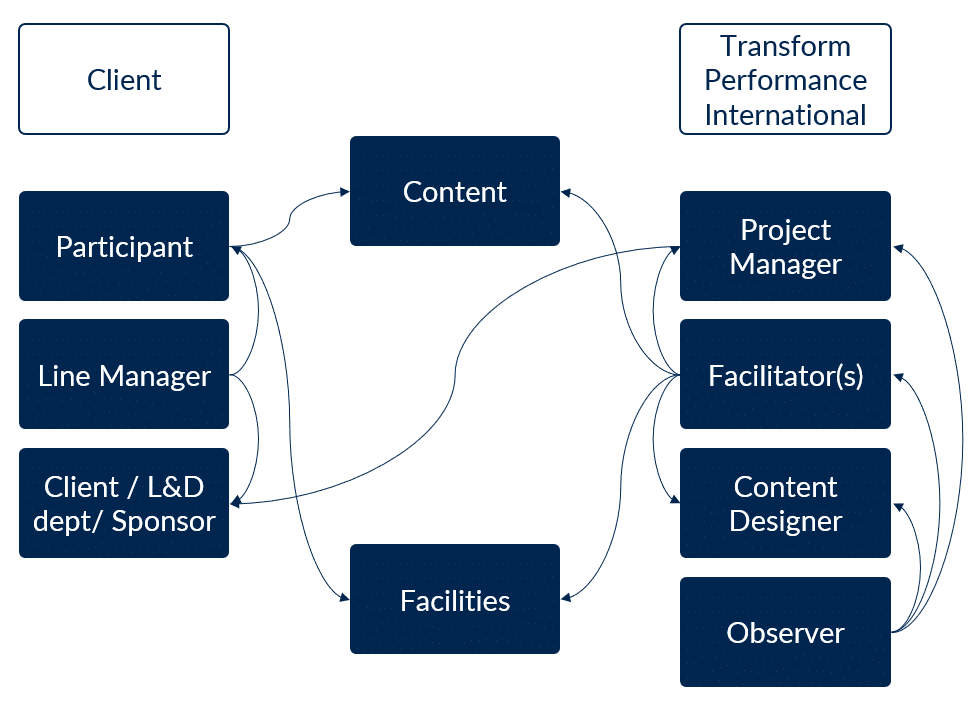Feedback is a powerful tool that can be leveraged to drive transformation and continuous improvement within organisations. We’ve worked long and hard to ensure feedback is at the centre of what we do. It serves to inform our continuous improvement but is also a valuable insight into whether we have achieved our goal of impacting beliefs and behaviours, therefore effecting sustainable change.
To achieve this, we go beyond traditional methods to gather insights from various stakeholders, including participants, facilitators, and client sponsors/managers as well as using known models and tools to structure how we use our feedback.
By analysing feedback patterns and trends, we identify areas for enhancement, utilising models like Kirkpatrick’s four levels of evaluation to assess learning at different stages.
In this blog we share our approach to provide a roadmap for organisations seeking to leverage feedback more effectively.
Embracing feedback for growth
Understanding the full impact of training and development programmes requires deeper insight than what is often gleaned from end-of-course forms, often referred to as “happy sheets.”
While these can indicate initial satisfaction, they frequently fail to measure long-term learning and behaviour change.
Going beyond “happy sheets”
We seek robust feedback mechanisms that capture the evolving perspectives of stakeholders over time. This can include seeking feedback throughout the programme and having a more robust formal feedback process after the event.
We also extend feedback requests to a wider group, including those who witness the impact of training in the workplace, to allow for a more comprehensive assessment of a programme’s effectiveness. This 360-degree view helps us to understand the ripple effect of our programmes. It allows us to pinpoint where the training intersects with actual work performance, and where it falls short. By capturing insights from the full spectrum of those involved or affected by our training, we can fine-tune our programmes to better serve the needs of our clients and ensure that the learning experience leads to meaningful, observable change in workplace behaviours and outcomes.
Taking a holistic approach to feedback not only provides a richer dataset for continuous improvement but also builds a culture of accountability and development within the organisation, something we call an ‘ecosystem’.

Engaging with metrics and data
When it comes to continuous improvement, feedback is not an endpoint but a gateway to actionable insights.
At TPI, we do not just collect feedback; we engage with it. We analyse quantitative data, and combine it with qualitative feedback, to paint a comprehensive picture of the impact of our work.
At the heart of this approach is Kirkpatrick’s Evaluation Model.
This provides a structured framework for assessing training effectiveness and we use it to guide us in evaluating the impact of our programmes across four levels:
- results – measurable improvements/organisational goals
- behaviour – practical application of learning/changes in performance
- learning – new knowledge and skills/learning outcomes
- reaction – was the training enjoyable, engaging and relevant?
This ensures that our feedback is not just surface level, but deeply rooted in tangible metrics and outcomes. It allows us to align our programmes more closely with our clients’ strategic goals and to continuously refine our offerings.
Identifying trends and patterns within the data enables us to make informed decisions about programme enhancements. Our data-driven approach ensures that each change we implement is not based on assumptions but on solid evidence of what works. By committing to this level of scrutiny, we ensure that the feedback we receive is not just heard but is meticulously used to forge pathways for growth and transformation.
The journey from data to action: analysing patterns and trends
When feedback is collected, the journey has only just begun. We then delve into the data, seeking out patterns and trends that can inform our decisions.
This analysis is critical. It helps us to understand more than just individual responses; it shows us where multiple learners may encounter similar issues or where particular aspects of our programmes consistently excel. By spotting these trends, we can apply targeted improvements, scaling up what works and reevaluating what doesn’t. This systematic approach to feedback analysis ensures that we’re not making changes based on isolated comments, but rather on evidence of broader experiences. It’s this kind of rigorous, data-informed action planning that allows us to continually refine our programmes and deliver on the promise of genuine transformation and continuous improvement.
It’s also important to close the loop on feedback wherever possible. That means responding to people who contribute to let them know of actions taken, improvements made, or even to seek more qualitative data to build a clearer picture. This is an important part of demonstrating the value we place on feedback as part of our overall business.

Building a feedback ecosystem
What we’ve described here is more than just a series of processes or actions.
We refer internally to our ‘evaluation and feedback ecosystem’ because we see this as a multi-faceted process.
Good scores are great, of course, but far more useful are data and trends that we can use to learn from and develop our own content and approach.
We believe that, to truly drive continuous improvement and transformation, feedback must be woven into the very fabric of an organisation’s business processes.
That’s why we embed feedback mechanisms at every stage of our programme development and delivery; it’s why we consider not just the content of our delivery, but the style, environment and experience too.
We make sure feedback is not an afterthought but a continuous input that shapes our services. This holds us accountable to the data we collect, and influences our planning, our execution, and our strategic direction.
We become more responsive and agile when designing our programmes and can quickly adapt to meet the evolving needs of our clients.
It’s through this dedication to making feedback a core component of our business processes that we can deliver the meaningful, effective, and transformative learning experiences that our clients depend on.
How to create your feedback ecosystem
If you want to create your own feedback ecosystem, here are some areas to focus on:
1. Aligning feedback with programme objectives
For feedback to be truly effective, it must correlate directly with the objectives of the programme it seeks to improve. We start by clearly defining the goals of each training initiative, then use these to develop targeted feedback questions and metrics. By aligning our feedback mechanisms with our programme objectives, we can ensure that the insights we gather are relevant and directly applicable to enhancing the programme’s effectiveness.
Importantly, participants and stakeholders can then also see the value of their feedback and the direct connection between their input and the programme’s evolution.
2. Sharing insights with participants and facilitators
The concept of an ecosystem is closely related to culture and so we have worked hard to be transparent about our process and to share feedback insights with both participants and facilitators. We have found this to promote a collaborative environment where all parties are invested in the growth and success of our training initiatives.
It encourages a sense of ownership and accountability, as participants and facilitators can see the tangible changes that result from the way we use feedback. By involving them in the feedback loop, we build trust and maintain high engagement levels, ensuring that our programmes are not just delivered but are co-created through a shared commitment to excellence and improvement.
3. Utilising feedback for programme development
Our feedback is a vital resource that informs every stage of programme creation. We use it to identify both the strengths and weaknesses of our programmes. This iterative approach ensures that our programmes evolve to meet changing market demands and learning styles.
By closely aligning programme content and delivery methods with the feedback received, we ensure that our training is relevant, engaging, and effective and contributes to our reputation as a leading provider of transformative learning experiences.
4. Improving feedback processes for better outcomes
Finally, the feedback process itself should be continually evolving to ensure the best possible outcomes. Recognising that a one-size-fits-all approach to feedback is ineffective, we tailor our feedback mechanisms to suit the unique context of each programme and its participants. We explore new methodologies for collecting and analysing feedback, ensuring that we’re not only gathering comprehensive data but also interpreting it in the most effective way. We also stay abreast of advancements that can enhance the way we capture and utilise feedback.
Finally, a last word about trust.
Feedback is a fundamental component of trust building. We recognise that by actively seeking and acting upon feedback, we show our clients that we are invested in their success and committed to delivering the highest quality service. All business relationships are based on having mutual respect and trust, especially if you want them to be long-term and successful. It’s also this trust that lays the foundation for our own organisational culture, where continuous improvement is not just encouraged but expected.
If what we’ve discussed in this piece resonates and you’d like to explore how we can help you with your development programmes, we’d love to hear from you.
Schedule a free consultation with us. We’ll be happy to discuss how we can leverage our experience to help your organisation and your people thrive.



